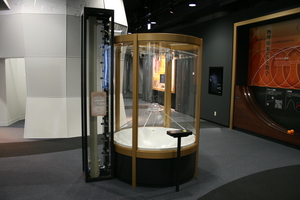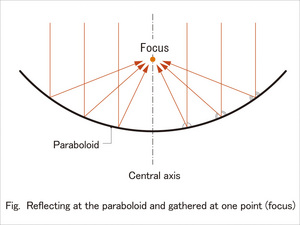Nagoya City Science Museum
TOP > Exhibition Guide > Keyword Search > Starting with "P" > parabolic surface > Reflection of Paraboloid
Reflection of Paraboloid



Purpose of Exhibition
The aim is to understand the nature of the big bowl shaped "paraboloid" on the floor.
If you experience this exhibit, you will understand why satellite antennas are shaped like this.
Additional Knowledge
Something with a bowl shape called a paraboloid is placed close to the floor. It is also reffered to as a 'parabolic antenna', which receives satellite broadcasts. It is basically, something with this shape but a little bigger.
Dropping a ball over the paraboloid, it is reflected. There is a basket hanging at the center of the paraboloid. When dropping a ball at any position of the paraboloid, it always goes into the basket hanging at the center of the paraboloid. One great feature of the paraboloid is that anything falling straight always gathers at the same position after reflection.
Paraboloid is a primarily mathematical term which means "parabolic".
"Parabolic" means the curved trajectory of a free-falling object. The curve is represented by the mathematic equation: y=ax^2A_=A^2The paraboloid of the exhibit is made up of parabolic surfaces: curved surfaces with rotating symmetric axis of the paraboloid.
If we made a vertical cut of the exhibit paraboloid, in the paraboloid, the lines parallel to the axis of symmetry reflected on the mirror gather at one point. This is the focus. In this exhibit, dropped balls rebound and gather at this focusSatellite broadcast-receiving antennas also use the principles found in this exhibit.
When the radio waves from satellites are received they are reflected in one point of the receiving antenna. You can receive the broadcast by placing the receiving antenna on that position.
Note) x ^ 2 stands for s "x squared.
Article by Yoshitaka Yamada, curator
